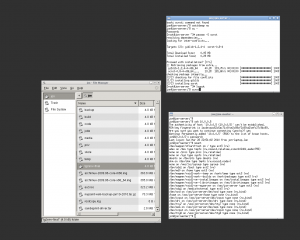At home I have a physical server that runs as a virtualization host (with kvm, lxc, qemu, libvirt and nfs), while the actual services I use run in virtualized servers, mostly as LXC containers.
One of these runs MPD and outputs music to the sound card of the host in addition to a web stream that I can access from anywhere in the world. Since the host and guest are using the same kernel, passing the soundcard on to the guest was as simple as bind mounting /dev/snd of the host into the root filesystem of the guest. I’m not quite sure how ALSA handles concurrent access, but it could be that this also works if several guests (or the host+guests) are playing to the same device.
But what is required to have working Xorg inside a cgroup/lxc container? Can we just do something similar? Turns out we can. Basic Xorg with the vesa driver and the old style input (no hal input hotplugging) works if you bind mount in /dev/tty7 (or another tty), /dev/mem, /dev/dri and /dev/input. Here is the obligatory screenshot:

Xorg running on the host graphics card from within a cgroup
So whats my motivation for trying this out? Curiosity mostly, but in a multi-seat system it could be nice to have each seat run as separate OS in a lxc container. It would allow each seat to run different distributions (within certain limits) and make sure that resources (CPU time, memory) are distributed evenly. And to provide isolation for security reasons.
That we need access to /dev/mem is currently a deal breaker as far as security goes, because it means that whoever gains root access in one of the guests will have control over the host (and thus the other guests) because they can modify the physical memory. There has been some interest in running Xorg as a unprivileged user, and that might address this issue. Locking it down with SELinux or similar might also be possible.
Obviously for multiseat you will need multiple screens somehow, either by using multiple cards or by sharing a single card (using one output each). I don’t immediately see any reason why the former should pose any problems, and with Dave Airlies recent work on multiple X servers on a single card that might also be possible in combination with cgroups/lxc.
I plan to test that this also works with the Intel driver, and perhaps also the Nvidia propriatary one with time. And perhaps try to get input with hal hotplugging working.